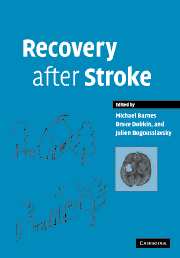Book contents
- Frontmatter
- Contents
- List of authors
- Preface
- 1 Stroke: background, epidemiology, etiology and avoiding recurrence
- 2 Principles of recovery after stroke
- 3 Regenerative ability in the central nervous system
- 4 Cerebral reorganization after sensorimotor stroke
- 5 Some personal lessons from imaging brain in recovery from stroke
- 6 Measurement in stroke: activity and quality of life
- 7 The impact of rehabilitation on stroke outcomes: what is the evidence?
- 8 Is early neurorehabilitation useful?
- 9 Community rehabilitation after stroke: is there no place like home?
- 10 Physical therapy
- 11 Abnormal movements after stroke
- 12 Spasticity and pain after stroke
- 13 Balance disorders and vertigo after stroke: assessment and rehabilitation
- 14 Management of dysphagia after stroke
- 15 Continence and stroke
- 16 Sex and relationships following stroke
- 17 Rehabilitation of visual disorders after stroke
- 18 Aphasia and dysarthria after stroke
- 19 Cognitive recovery after stroke
- 20 Stroke-related dementia
- 21 Depression and fatigue after stroke
- 22 Sleep disorders after stroke
- 23 Technology for recovery after stroke
- 24 Vocational rehabilitation
- 25 A patient's perspective
- Index
6 - Measurement in stroke: activity and quality of life
Published online by Cambridge University Press: 05 August 2016
- Frontmatter
- Contents
- List of authors
- Preface
- 1 Stroke: background, epidemiology, etiology and avoiding recurrence
- 2 Principles of recovery after stroke
- 3 Regenerative ability in the central nervous system
- 4 Cerebral reorganization after sensorimotor stroke
- 5 Some personal lessons from imaging brain in recovery from stroke
- 6 Measurement in stroke: activity and quality of life
- 7 The impact of rehabilitation on stroke outcomes: what is the evidence?
- 8 Is early neurorehabilitation useful?
- 9 Community rehabilitation after stroke: is there no place like home?
- 10 Physical therapy
- 11 Abnormal movements after stroke
- 12 Spasticity and pain after stroke
- 13 Balance disorders and vertigo after stroke: assessment and rehabilitation
- 14 Management of dysphagia after stroke
- 15 Continence and stroke
- 16 Sex and relationships following stroke
- 17 Rehabilitation of visual disorders after stroke
- 18 Aphasia and dysarthria after stroke
- 19 Cognitive recovery after stroke
- 20 Stroke-related dementia
- 21 Depression and fatigue after stroke
- 22 Sleep disorders after stroke
- 23 Technology for recovery after stroke
- 24 Vocational rehabilitation
- 25 A patient's perspective
- Index
Summary
Introduction
Stroke is a significant cause of limitations in activity and participation in adult life. Effective rehabilitation for patients with stroke is crucial to minimize the impact of impairment and maximize the reintegration of that person into their community, with an optimal quality of life QoL. Measuring the effectiveness of intervention is essential both to demonstrate that rehabilitation has happened and, potentially, to guide practice for future management.
When considering intervention or outcome measurement, amodel of illness is helpful to categorize and classify data collected. The most widely accepted model of illness is that promulgated by the World Health Organization (WHO): the International Classification of Impairments, Disabilities, and Handicaps (ICIDH) (WHO, 1980). This model differentiates the following broad categories: organ system performance, performance of activities of daily living (ADL) at the person level, and role performance as a member of society. The WHO has recently proposed a new model: the International Classification of Functioning, Disability and Health (ICF;WHO, 2001). This revision has seen the retention of these broad categories but replaced the terms disability and handicap by more positive and meaningful terms, activity and participation, respectively. It is these concepts that are used as constructs for outcome measurement in rehabilitation.
Measurement of outcome
The search for appropriate outcome measures, used to determine the intended effect of a process or treatment, continues as a focus within rehabilitation research. The goal is to develop instruments that measure and quantify the intended effect across a range of outcomes from activity to QoL and to assess and evaluate the results from instrument use and, thus, determine the effectiveness of that intervention. Sucheffectiveness is, though, subject to external variance effects of comorbidity, social, and societal factors.
A major issue in pursuing outcome measures is the adequacy of the tool, which should satisfy the following essential criteria.
Validity. A measurement is valid if it accurately describes the underlying phenomenon or disease (Nunnally, 1978; Asplund, 1987; Spector, 1990). Three main types of validity are generally recognized: construct, criterion related, and content validity.
Reliability. A test is reliable if the measurement error is minimal (Nunnally, 1978). There should be minimal intra- or inter-observer variability.
- Type
- Chapter
- Information
- Recovery after Stroke , pp. 135 - 160Publisher: Cambridge University PressPrint publication year: 2005
- 8
- Cited by



